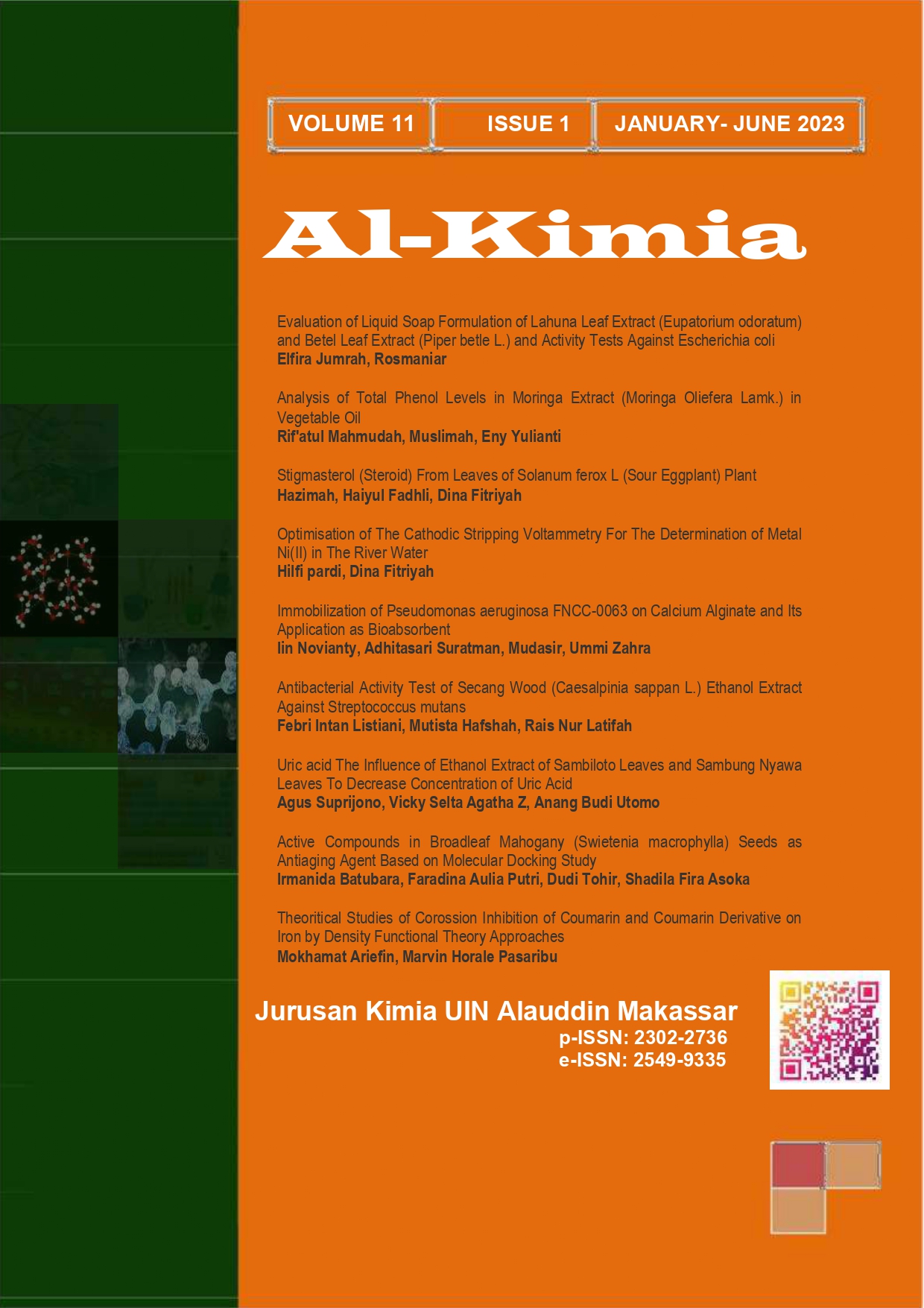Secondary Metabolites and Antioxidant Activity of Methanol Extract and Fractions from the Root of Gitaan (Willughbeia coreacea Wall)
Abstract
Gitaan (Willughbeia coreaceae) is one of Indonesian endemic plants and belongs to Apocynaceae family that is potential for antioxidant source. This family contains triterpenoids, phenolics, alkaloids, and cardenolides, unfortunately information about secondary metabolites together with its biological activities from W. coreaceae is scarce. This study was conducted to determine secondary metabolites and antioxidant activity from the methanol extract and fractions of gitaan root. The root powder was macerated, its secondary metabolites were analyzed by phytochemical test and the antioxidant activity was evaluated by the qualitative and quantitative DPPH (1,1-diphenyl-2-picrylhydrazil) methods with the ascorbic acid was used as a positive control. Results showed the methanol extract and methanol fraction have alkaloids, polyphenols, and terpenoids, and ethyl acetate and n-hexane fractions contained alkaloids and polyphenols. By DPPH qualitative, all samples except for n-hexane fraction showed antioxidant properties which were indicated by yellow stains on the thin layer chromatography (TLC) plate after sprayed with 50 ppm of DPPH. By quantitative, methanol extract and fractions of methanol, ethyl acetate, n-hexane, and the ascorbic acid showed antioxidant activity with IC50 values of 44.1181 ppm, 45.4060 ppm, 57.2484 ppm, 983.9576 ppm, and 0.0445 ppm, respectively. Subsequently, methanol extract has better antioxidant activity then other fractions.
Downloads
References
Budiyanto, M. S. A. 2015. Potensi antioksidan, inhibitor torisinase dan nilai toksisitas dari beberapa spesies tanaman mangrove di Indonesia. Unpublised master’s thesis, Bogor: Institut Pertanian Bogor.
Chan, E. W. C., Wong, S. K., & Chan, H. T. 2016. Apocynaceae species with antiproliferative and/or antiplasmodial properties: a review of ten genera. Journal of Integrative Medicine, 14(4): 269-284.
Harborne, J. B. 1998. Textbook of phytochemical methods. A guide to modern techniques of plant analysis. (5th ed) Chapman and Hall Ltd, London.
Indri, V. M., Victoria, Y. F., Lizma, F., & Laode, R. 2016. Identifikasi metabolit sekunder dan aktivitas antioksidan ekstrak bunga tapak dara (Catharanthus roseus). Prosiding Seminar Nasional Kefarmasian Ke-4, Samarinda.
Jafar, W., Masriany, & Sukmawaty, E. 2020. Uji fitokimia ekstrak etanol bunga pohon hujan (Spathodea campanulata) secara in vitro. Prosiding seminar nasional biotik, ISBN 97-602-60401-3-x. E-ISSN: 2828-1675.
Kruakaew, S., Seeka, C., Lhinhatrakool, T., Thongnest, S., Yahuafai, J., Piyaviriyakul, S., Siripong, P., & Sutthivaiyakit, S. 2017. Cytotoxic cardiac glycoside constituents of Vallaris glabra leaves. Journal of Natural Products, 80: 2987-2996.
Liu, L., Cao, J. X., Yao, Y. C., & Xu, S. P. 2013. Progress of pharmacological studies on alkaloids from Apocynaceae. Journal of Asian Natural Products Research, 15(2): 166-84.
Middleton, D. J. 2004. Tree Flora of Sabah and Sarawak. 5, 1-61.
Molyneux, P. 2003. The use of the stable free radical diphenylpicryl-hydrazyl (DPPH) for estimating antioxidant activity. Songklanakarin Journal of Science and Technology, 26(2): 211-219.
Perry, L. M. 1980. Medicinal plants of east and southeast Asia: Attributed properties and uses. The MIT Press, Massachusett. p.32.
Purwanto, D., Bahri, S., & Ridhay, A. 2017. Uji aktivitas antioksidan ekstrak buah purnajiwa (Kopsia arborea Blume.) dengan berbagai pelarut. Kovalen, 3(1): 24 – 32.
Shi, B. B., Ai, H. L., Duan, K. T., Feng, T., & Liu, J. K. (2022). Ophiorrhines F and G, Key biogenetic intermediates of ophiorrhine alkaloids from Ophiorrhiza japonica and their immunosuppressant activities. Journal of Natural Products, 85: 453-457.
Zhang, J., Yuan, M. F., Li, S. T., Sang, C. C., Chen, M. F., Ao, Y. L., Li, Z. W., Xie, J., Ye, W. C., and Zhang, X. Q. 2020. Hunzeylanines A−E, Five bisindole alkaloids tethered with a methylene group from the roots of Hunteria zeylanica. The Journal of Organic Chemistry. 85: 10884-10890.
Zhu, X. X., Fan, Y. Y., Xu, L., Liu, Q. F., Wu. J. P., Li, J. Y., Li, J., Gao, K., & Yue, J. M. (2019). Alstonlarsines A−D, four rearranged indole alkaloids from Alstonia scholaris. Organic Letters, 21: 1471-1474.
Zuraida, Sulistiyani, Sajuthi, D., & Suparto I. H. 2017. Fenol, flavonoid, dan aktivitas antioksidan pada ekstrak kulit batang pulai (Alstonia scholaris R.Br). Jurnal Penelitian Hasil Hutan, 35(3): 211-219.
Authors who publish with this journal agree to the following terms:
1) Authors retain copyright and grant the journal right of first publication with the work simultaneously licensed under a Creative Commons Attribution License that allows others to share the work with an acknowledgement of the work's authorship and initial publication in this journal.
2) Authors are able to enter into separate, additional contractual arrangements for the non-exclusive distribution of the journal's published version of the work (e.g., post it to an institutional repository or publish it in a book), with an acknowledgement of its initial publication in this journal.
3)Authors are permitted and encouraged to post their work online (e.g., in institutional repositories or on their website) prior to and during the submission process, as it can lead to productive exchanges, as well as earlier and greater citation of published work (See The Effect of Open Access).


